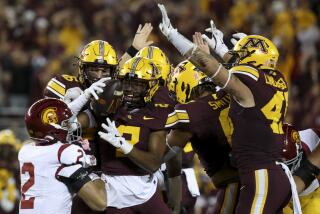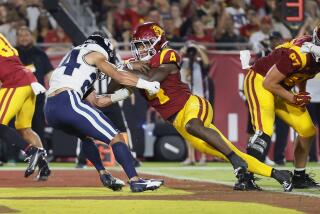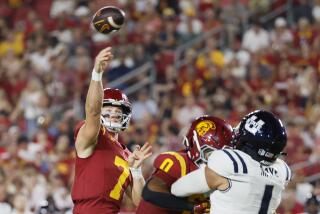USC needs to find a cure for the hiccups
A reader this week complained in an e-mail about the river flow of nauseating praise being heaped on USC when, in fact, the Trojans really haven’t been that dominant in the Pete Carroll era.
Half of those six straight Pacific 10 Conference titles, after all, were shares of championships.
And it’s not as if Carroll (two) has won as many national titles as Bear Bryant (six).
It got me thinking about expectations.
Maybe the Trojans, in a historical, Mt. Rushmore context, have underachieved.
Carroll’s 49-9 conference record in seven years may rank him No. 1 all-time in Pac-10 winning percentage, but one of those nine defeats was by seven points.
How do you return home and face loved ones after that, especially when the other defeats were by three, two, five, three, three, one, two and four points?
People talk about national titles in 2003 and 2004, but what about three other titles USC drop-kicked away?
Three years ago, USC blew a fourth-quarter lead in a three-point title-game loss to Texas.
In 2006, a four-point loss to rival UCLA denied USC a beeline to a Bowl Championship Series title-game matchup against Ohio State.
Last year, an unforgivable home loss to 41-point underdog Stanford cost USC another trip to the national title game.
If you want to throw in 2002, Carroll’s second year at USC, the Trojans finished No. 4 in the BCS standings after losses to Kansas State and Washington State by a combined 10 points.
You call that dynastic?
It shows you how hairsplitting the dissection of dominance can get.
Sometimes “nit” is the only pick.
The poll vault bar is set so high it doesn’t matter that USC has only four starters returning on offense, lost seven first- or second-round players to the NFL, and starts the season on the road with a new quarterback.
USC, people figure, will figure it out.
Matt Leinart had never taken a game-action snap at quarterback before the 2003 opener at Auburn. That turned out to be a 23-0K win that sparked a season that ended with a split national title.
USC starts anew today, ranked No. 3 in the Associated Press media poll and No. 2 by the coaches.
There is no easing into seasons anymore. “We’re going for it and that’s the only way we know how to do it,” Carroll said this week.
The question isn’t whether USC is going to win 10 games.
The question is whether USC can win 11 or 12 and avoid the hiccups that have foiled national title runs each of the last three years.
The table, once again, is set to run. All the presumably tough games -- Ohio State, Oregon, Arizona State, California, Notre Dame -- are at home.
USC should handle Virginia in Charlottesville and then gets two weeks to prepare for Ohio State.
The glitter games, though, haven’t always been the ones that trip the Trojans. So watch out for Oregon State in Corvallis on a Thursday night, Sept. 25.
It was the Beavers who, two years ago, claimed one of those nine Pac-10 wins against Carroll.
Oregon and Arizona State are good-looking home games on the USC season-ticket plan, but the games after that are at Washington State and at Arizona.
USC barely escaped Pullman only two years ago while Arizona, under Mike Stoops, has played the Trojans tighter than stretch pants.
Last year, the week after the Stanford debacle, a raging-mad USC was supposed to kick Arizona’s A, only it didn’t happen. Instead, with Mark Sanchez at the helm, the Trojans wiped a collective brow after escaping with a seven-point home win.
Stoops might have even more incentive this year -- keeping his job.
The Trojans are home for Washington and California but away Nov. 15 against Stanford, 1-0 against USC last year and already 1-0 in the Pac-10 this year.
The season ends with Notre Dame and UCLA, the Trojans’ two biggest rivals, but those might be more comfortable pencil-ins than Oregon State or Arizona.
Dream big this year, USC, but don’t take a cat nap.
Think title but also think Tucson.
The big BCS bowl USC wants to play in may go through the regular-season Rose, on Dec. 6, where UCLA and its marketing department await.
Fordham once had its “Seven Blocks of Granite.”
UCLA, for now, has its “Five Columns of Ad Type.”
You have to start somewhere
What the heck, it’s only monopoly money.
--
More to Read
Go beyond the scoreboard
Get the latest on L.A.'s teams in the daily Sports Report newsletter.
You may occasionally receive promotional content from the Los Angeles Times.







